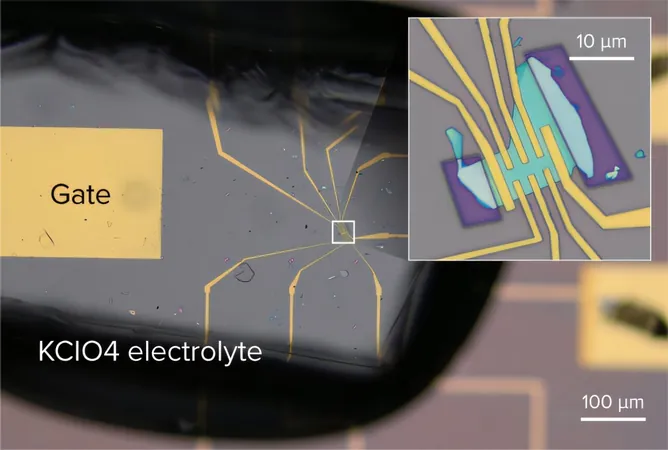
Breakthrough Discovery: Transistor Magic Transforms 2D Material Properties
2025-03-27
Author: Ming
Researchers at RIKEN have made a stunning revelation that could revolutionize the electronics industry: they found a way to manipulate the electronic characteristics of molybdenum disulfide (MoS2)—a promising 2D material—by using potassium ions and a specially designed transistor. This innovative discovery allows this single material to switch between being a metal, semiconductor, insulator, or even a superconductor, depending on how it is treated.
Published in the journal Nano Letters, this study showcases a fantastic leap in materials science and opens doors to unprecedented applications in next-generation semiconductor devices. According to Yoshihiro Iwasa, head of the RIKEN Center for Emergent Matter Science and leader of the research team, “The variety of electronic properties based on a single material is highly intriguing to us.”
Molybdenum disulfide is composed of layers of molybdenum atoms encapsulated by sulfur atoms, with different configurations leading to distinct phases—2H, which behaves as a semiconductor, and 1T, which acts like a metal. RIKEN researchers specifically focused on the 2H phase given its potential for advanced semiconductor applications.
By constructing a field-effect transistor and connecting it to 2H molybdenum disulfide, they cleverly varied the voltage to guide potassium ions into the material. When the ratio of potassium ions reached two for every five molybdenum atoms, they observed a dramatic transformation: the material transitioned from the 2H phase to the conductive 1T phase.
The researchers then discovered an unexpected twist in their findings. By adding the right amount of potassium ions and cooling the sample to an ultra-low temperature of -268°C, the 1T phase exhibited superconductivity—a phenomenon previously only linked to the 2H structure. “The biggest surprise for us is that we observed superconductivity when we introduced potassium ions,” Iwasa highlighted, showcasing the excitement within the research team.
Moreover, the team noticed another fascinating behavior. When potassium ions were slowly drained from the 1T molybdenum disulfide, the material transitioned from being metallic to insulating at -193°C. This unexpected result showcases the versatility of the material and raises numerous questions about the underlying mechanisms at play.
This groundbreaking research indicates that manipulating potassium ions presents a potent method for fine-tuning the properties of 2D materials like molybdenum disulfide. The implications are vast, as this approach could pave the way for the development of new superconductors and revolutionary electronic devices that operate at unprecedented efficiency levels.
Iwasas noted, “We’ve been developing this method over the past decade, and we’ve shown that it is useful not only for exploring novel properties of superconductors and related electronic phases but also for discovering new superconductors.”
Stay tuned, as this research continues to unravel the mysteries of materials science in the age of nanotechnology!




 Brasil (PT)
Brasil (PT)
 Canada (EN)
Canada (EN)
 Chile (ES)
Chile (ES)
 Česko (CS)
Česko (CS)
 대한민국 (KO)
대한민국 (KO)
 España (ES)
España (ES)
 France (FR)
France (FR)
 Hong Kong (EN)
Hong Kong (EN)
 Italia (IT)
Italia (IT)
 日本 (JA)
日本 (JA)
 Magyarország (HU)
Magyarország (HU)
 Norge (NO)
Norge (NO)
 Polska (PL)
Polska (PL)
 Schweiz (DE)
Schweiz (DE)
 Singapore (EN)
Singapore (EN)
 Sverige (SV)
Sverige (SV)
 Suomi (FI)
Suomi (FI)
 Türkiye (TR)
Türkiye (TR)
 الإمارات العربية المتحدة (AR)
الإمارات العربية المتحدة (AR)